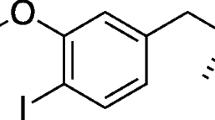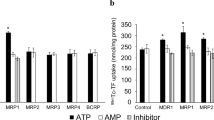Abstract
Purpose
Radionuclide therapy with 131I-labelled meta-iodobenzylguanidine ([131I]MIBG) is effective in cases where it is difficult to carry out surgical resection or debulking of neuroendocrine tumours (NETs). However, it has recently been reported that P-glycoprotein (P-gp) is expressed in these NETs. Therefore, it is important to clarify whether MIBG is a substrate of P-gp or not. In this study, using a human cell line which overexpresses P-gp, LLC-GA5-COL150, we investigated this question.
Methods
The transcellular transport and accumulation of [125I]MIBG were measured using monolayer cultures grown in Transwell chambers. [125I]MIBG was added to either the basolateral or the apical side, aliquots of the incubation medium on the other side were taken at specified times, and the radioactivity was measured. For accumulation experiments, the cells on the filters were solubilised and the radioactivity in aliquots was measured.
Results
There were no significant differences in the transport of MIBG between LLC-PK1 and LLC-GA5-COL150 monolayers in either direction until 60 min. With respect to the accumulation of MIBG, there were no significant differences between LLC-PK1 and LLC-GA5-COL150 cells in either direction.
Conclusion
MIBG is not a substrate of P-gp. Therefore, radionuclide therapy with MIBG would be useful in the treatment of NETs expressing P-gp.




Similar content being viewed by others

References
Bombardieri E, Seregni E, Villano C, Chiti A, Bajetta E. Position of nuclear medicine techniques in the diagnostic work-up of neuroendocrine tumors. Q J Nucl Med Mol Imaging 2004;48:150–3.
Chamberlain RS, Canes D, Brown KT, Saltz L, Jarnagin W, Fong Y, et al. Hepatic neuroendocrine metastases: does intervention alter outcomes? J Am Coll Surg 2000;190:432–5.
Carty SE, Jensen RT, Norton JA. Prospective study of aggressive resection of metastatic pancreatic endocrine tumors. Surgery 1992;112:1024–31; discussion 1031–2.
Norton JA, Warren RS, Kelly MG, Zuraek MB, Jensen RT. Aggressive surgery for metastatic liver neuroendocrine tumors. Surgery 2003;134:1057–3; discussion 1063–5.
Wieland DM, Wu J, Brown LE, Mangner TJ, Swanson DP, Beierwaltes WH. Radiolabeled adrenergi neuron-blocking agents: adrenomedullary imaging with [131I]iodobenzylguanidine. J Nucl Med 1980;21:349–53.
Wafelman AR, Hoefnagel CA, Maes RA, Beijnen JH. Radioiodinated metaiodobenzylguanidine: a review of its biodistribution and pharmacokinetics, drug interactions, cytotoxicity and dosimetry. Eur J Nucl Med 1994;21:545–59.
Mukherjee JJ, Kaltsas GA, Islam N, Plowman PN, Foley R, Hikmat J, et al. Treatment of metastatic carcinoid tumours, phaeochromocytoma, paraganglioma and medullary carcinoma of the thyroid with 131I-meta-iodobenzylguanidine [131I-mIBG]. Clin Endocrinol (Oxf) 2001;55:47–60.
Safford SD, Coleman RE, Gockerman JP, Moore J, Feldman JM, Leight GS Jr, et al. Iodine -131 metaiodobenzylguanidine is an effective treatment for malignant pheochromocytoma and paraganglioma. Surgery 2003;134:956–62; discussion 962–3.
Bomanji JB, Wong W, Gaze MN, Cassoni A, Waddington W, Solano J, et al. Treatment of neuroendocrine tumours in adults with 131I-MIBG therapy. Clin Oncol (R Coll Radiol) 2003;15:193–8.
Safford SD, Coleman RE, Gockerman JP, Moore J, Feldman J, Onaitis MW, et al. Iodine-131 metaiodobenzylguanidine treatment for metastatic carcinoid. Results in 98 patients. Cancer 2004;101:1987–93.
Campling BG, Young LC, Baer KA, Lam YM, Deeley RG, Cole SP, et al. Expression of the MRP and MDR1 multidrug resistance genes in small cell lung cancer. Clin Cancer Res 1997;3:115–22.
Chan HS, Haddad G, Thorner PS, DeBoer G, Lin YP, Ondrusek N, et al. P-glycoprotein expression as a predictor of the outcome of therapy for neuroblastoma. N Engl J Med 1991;325:1608–14.
De Moerloose B, Van de Wiele C, Dhooge C, Philippe J, Speleman F, Benoit Y, et al. Technetium-99m sestamibi imaging in paediatric neuroblastoma and ganglioneuroma and its relation to P-glycoprotein. Eur J Nucl Med 1999;26:396–403.
Goldstein LJ, Galski H, Fojo A, Willingham M, Lai SL, Gazdar A, et al. Expression of a multidrug resistance gene in human cancers. J Natl Cancer Inst 1989;81:116–24.
Gottesman MM, Fojo T, Bates SE. Multidrug resistance in cancer: role of ATP-dependent transporters. Nat Rev Cancer 2002;2:48–58.
Ambudkar SV, Kimchi-Sarfaty C, Sauna ZE, Gottesman MM. P-glycoprotein: from genomics to mechanism. Oncogene 2003;22:7468–85.
Tanigawara Y, Okamura N, Hirai M, Yasuhara M, Ueda K, Kioka N, et al. Transport of digoxin by human P-glycoprotein expressed in a porcine kidney epithelial cell line (LLC-PK1). J Pharmacol Exp Ther 1992;263:840–5.
Soares-Da-Silva P, Serrao MP. Outward transfer of dopamine precursor L-3,4-dihydroxyphenylalanine (L-dopa) by native and human P-glycoprotein in LLC-PK1 and LLC-GA5 col300 renal cells. J Pharmacol Exp Ther 2000;293:697–704.
Saito H, Yamamoto M, Inui K, Hori R. Transcellular transport of organic cation across monolayers of kidney epithelial cell line LLC-PK. Am J Physiol 1992;262:C59–66.
Ohtomo T, Saito H, Inotsume N, Yasuhara M, Inui KI. Transport of levofloxacin in a kidney epithelial cell line, LLC-PK1: interaction with organic cation transporters in apical and basolateral membranes. J Pharmacol Exp Ther 1996;276:1143–8.
Takami K, Saito H, Okuda M, Takano M, Inui KI. Distinct characteristics of transcellular transport between nicotine and tetraethylammonium in LLC-PK1 cells. J Pharmacol Exp Ther 1998;286:676–80.
Urakami Y, Kimura N, Okuda M, Masuda S, Katsura T, Inui K. Transcellular transport of creatinine in renal tubular epithelial cell line LLC-PK1. Drug Metab Pharmacokinet 2005;20:200–5.
Acknowledgements
We would like to thank Daiichi Radioisotope Laboratories Ltd., Tokyo, Japan, for providing [125I]MIBG. This study was supported in part by Grants-in-aid for General Scientific Research from the Ministry of Education, Culture, Sports, and Science.
Author information
Authors and Affiliations
Corresponding author
Rights and permissions
About this article
Cite this article
Kiyono, Y., Yamashita, T., Doi, H. et al. Is MIBG a substrate of P-glycoprotein?. Eur J Nucl Med Mol Imaging 34, 448–452 (2007). https://doi.org/10.1007/s00259-006-0256-6
Received:
Accepted:
Published:
Issue Date:
DOI: https://doi.org/10.1007/s00259-006-0256-6



